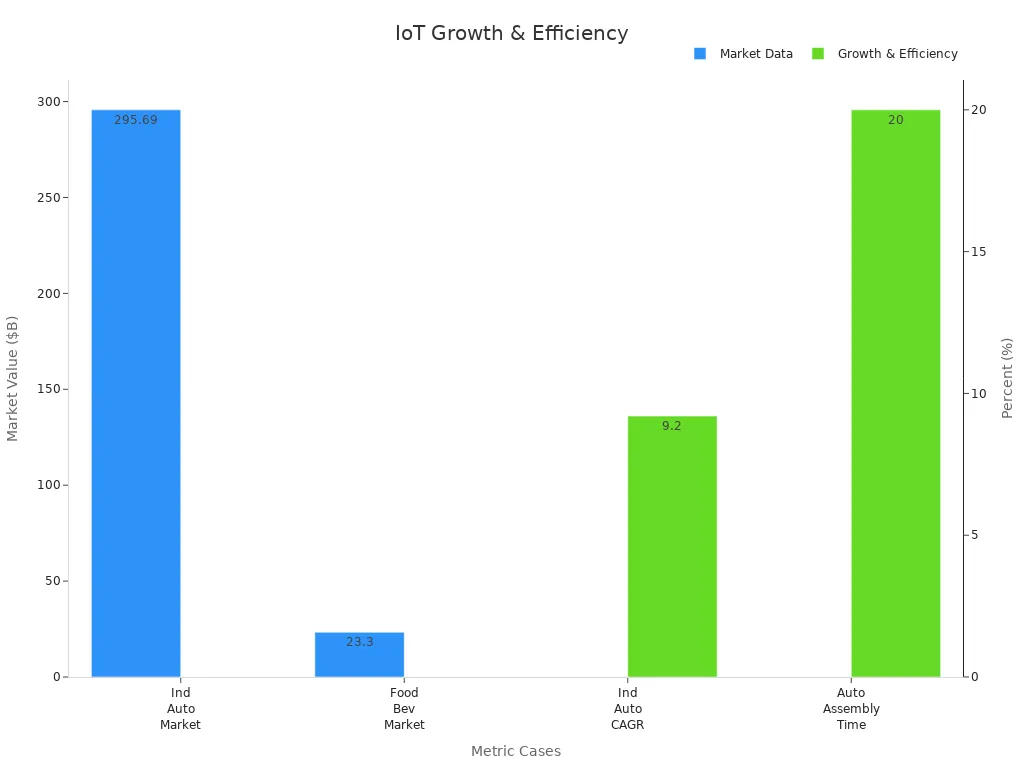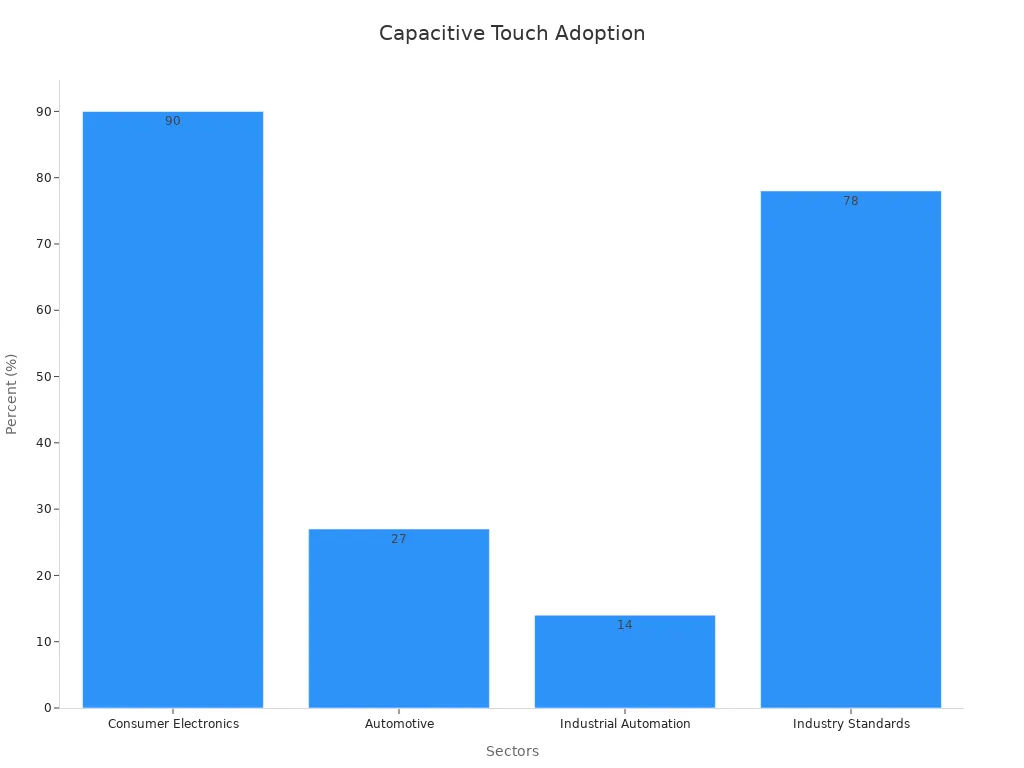

In 2025, innovative push button switch designs have redefined how people interact with technology at home and in industry. The push button complete units market has soared to an estimated $2.5 billion, driven by smart features, miniaturization, and enhanced durability. The table below highlights the latest trends and growth in this market:
| Aspect | Details |
|---|---|
| Market Size (2025) | $2.5 billion |
| Projected CAGR | 5% |
| Growth Drivers | Miniaturization, smart features, IoT, home |
| Notable Developments | Miniature switches, smart connectivity, home |
| Expansion Sectors | Home, automotive, industrial, medical |
A focus on smart technology, advanced home connectivity, and sustainability shapes the future of pushbutton switches. Designers now prioritize both aesthetics and ruggedness, reflecting the latest trends and the demand for reliable, innovative push button switch solutions in the home and beyond. The push button complete units market continues to evolve, fueled by innovation, smart capabilities, and the needs of modern home environments.
Smart technology leads the latest trends in push button switch design. In 2025, manufacturers focus on integrating advanced features that enhance both convenience and efficiency. Smart push button switches now connect seamlessly with smart home ecosystems, allowing users to control lighting, security, and climate with a single touch or voice command. These switches support wireless protocols, making installation easier and reducing the need for complex wiring.
Real-world applications highlight the impact of these trends. For example, a luxury hotel in Dubai implemented KNX smart switches to automate room settings, door locks, and minibars. Guests experience one-touch housekeeping and synchronized do-not-disturb modes. This innovation led to an 18% reduction in annual energy costs and a 97% guest satisfaction rate. In high-end villas in Shanghai, smart push button switches create personalized scenarios like "Dinner Party Mode," increasing property value by up to 8%.
Smart home ecosystems benefit from these trends by offering:
Reduced operating expenses through energy-efficient lighting and climate control.
Increased property value and resident satisfaction.
Enhanced operational efficiency with automated maintenance and access control.
Improved security and faster response times.
Property managers track key metrics such as utility savings, maintenance cost reductions, and resident feedback to measure the return on investment. They often start with a single smart technology, monitor results, and scale up successful implementations across multiple properties.
IoT integration stands at the core of modern push button switch trends. These switches now serve as vital nodes in smart home and industrial networks. IoT-enabled push button switches collect real-time data, support predictive maintenance, and enable remote diagnostics. Wireless connectivity ensures that devices communicate efficiently, even in large buildings or across multiple locations.
The push button complete units market has seen rapid growth due to IoT integration. In industrial automation, the market is projected to reach $295.69 billion by 2026, with a compound annual growth rate of 9.2%. Food and beverage automation, which relies on smart push button switches, is expected to hit $23.3 billion by 2027. Automotive manufacturers report a 20% reduction in assembly time after switching from toggle to momentary push button switches, boosting productivity and reducing errors.
| Metric/Case Study | Numerical Data/Result | Description/Impact |
|---|---|---|
| Industrial Automation Market Size | $295.69 billion by 2026 | Projected market size indicating significant growth in industrial automation involving pushbutton switches. |
| CAGR of Industrial Automation Market | 9.2% (2021-2026) | Compound annual growth rate reflecting rapid expansion of automation technologies. |
| Food and Beverage Automation Market Size | $23.3 billion by 2027 | Projected market size showing adoption of automation including pushbutton switches in food/beverage industry. |
| Automotive Assembly Time Reduction | 20% reduction | Efficiency improvement after switching from toggle to momentary push-button switches, enhancing productivity and reducing errors. |
| IoT Integration Example | AWS IoT SiteWise and AWS IoT FleetWise | Enables live data collection, maintenance prediction, and downtime reduction through smart pushbutton switches. |

Wireless push button switches play a key role in smart factories and smart home ecosystems. They enable real-time monitoring, predictive device health warnings, and faster response to security alarms. These trends drive the push button complete units market forward, supporting both home and industrial applications.
AI features represent a major leap in push button switch innovation. Manufacturers now embed machine learning algorithms in push button switches to analyze user behavior and create personalized scene modes. For example, AI can activate "Cinema Mode" automatically when it detects certain patterns, adjusting lighting and climate for the perfect movie night.
Voice-activated push button switches have become a standard in smart home ecosystems. These switches respond to voice commands, allowing users to control devices hands-free. In schools, hospitals, and homes, AI-powered push button switches predict power consumption, adapt to user preferences, and provide proactive maintenance alerts up to 30 days in advance. This reduces downtime and extends device lifespan.
A recent school project used remote diagnostics and AI to monitor relay wear and communication strength. The result was a 50% reduction in maintenance costs and an increase in device lifespan from 10 to over 15 years. Hospitals achieved zero-failure operation by addressing power separation design issues, demonstrating the importance of compliance and technological innovation.
Tip: Voice-activated push button switches not only improve accessibility for all users but also enhance safety by enabling touchless operation in sensitive environments.
The push button complete units market continues to expand as AI features become more common in both home and industrial settings. These trends ensure that push button switches remain at the forefront of smart systems, supporting the latest trends in connectivity, automation, and user experience.
Tactile feedback stands as a defining feature in modern push button switch design. Users expect immediate confirmation when they press a button. Contemporary push button switches deliver both tactile and auditory cues, which increase precision and boost user confidence. Designers use activation force as a key metric. In automotive settings, higher activation forces prevent accidental presses, while in home electronics, lower forces allow for quick, responsive actions. Studies show that users can distinguish and prefer certain tactile sensations. Hedonic ratings and semantic differential evaluations reveal that people value a satisfying "click" and clear feedback. These preferences guide manufacturers to create push button switch solutions that feel reliable and enjoyable in daily use.
Ergonomics plays a critical role in the success of push button switch products. Designers tailor activation force and button size to fit specific applications. In home environments, users benefit from switches that require minimal effort, making them accessible for all ages. In industrial and automotive markets, designers increase activation force to ensure safety and prevent accidental activation. Kansei engineering helps evaluate how users perceive comfort and usability. By measuring physical properties like force and stroke, engineers align switch performance with user expectations. This approach leads to higher satisfaction and improved usability across home and industrial markets.
Note: Ergonomic push button switch design reduces fatigue and supports long-term use, especially in smart home ecosystems and high-use market segments.
Aesthetics now influence the market for push button switch products as much as function. Consumers want switches that match the style of their home or smart devices. Manufacturers offer customizable push buttons in various colors, finishes, and shapes. Kansei engineering links physical switch characteristics to emotional responses, such as pleasantness and visual appeal. Luxury automotive markets show that users prefer switches with refined tactile and visual qualities. Designers use these insights to create push button switch solutions that enhance both the look and feel of home and smart environments. Attractive, well-designed switches help brands stand out in a crowded market.

Capacitive touch technology has transformed the push button switch market. Manufacturers now use advanced touch-sensitive technology to create sleek, flat surfaces that respond to the lightest touch. This approach eliminates moving parts, which increases durability and makes cleaning easier. In consumer electronics, capacitive touchscreens appear in about 90% of smartphones, tablets, and wearables. Apple Face ID uses capacitive sensing for secure access. The automotive market also benefits, with 27% of capacitive sensor applications found in vehicles. Tesla Model 3 features capacitive touch buttons for climate control, supporting a minimalist cockpit design.
| Sector/Industry | Evidence of Increased Adoption | Key Benefits/Drivers |
|---|---|---|
| Consumer Electronics | Capacitive touchscreens embedded in ~90% of smartphones, tablets, wearables; Apple Face ID uses capacitive sensing | Precision, durability, multi-touch, bezel-less displays, gesture control, proximity detection |
| Automotive | 27% of capacitive sensor applications; Tesla Model 3 uses capacitive touch buttons for climate control | Enhanced user interfaces, minimalist cockpit design, safety features like occupant detection |
| Industrial Automation | Use in non-contact level detection, robotics, predictive maintenance; 14% YoY demand growth in 2023 | Hygiene, contamination prevention, durability, Industry 4.0 integration |
| Healthcare | Capacitive sensors in medical devices, neonatal ICUs, glucose monitors | Hygienic operation, non-contact monitoring, accuracy, continuous health tracking |
| Smart Home Technology | Over 70 million devices shipped in 2023 with capacitive interfaces | Touchless light switches, proximity-activated faucets, hygiene-driven demand post-pandemic |
| Material Innovation | Graphene-based films, flexible sensors for foldable displays and curved panels | Improved performance, flexibility, energy efficiency, enabling novel applications |
| Industry Standards | Compliance with IEC 60947-5-2 and Qi wireless charging standards | Customer confidence, interoperability, reduced vendor lock-in, preferred by 78% of automation engineers |
Industry experts note that capacitive touch technology is replacing mechanical buttons in many applications. Companies like NextInput develop force touch and gesture control solutions to address challenges such as glove and wet finger use. The market trend moves toward eliminating mechanical switches, favoring capacitive and touchless interfaces for more intuitive and hygienic controls.

Touchless operation has become a key driver in the push button switch market. This technology uses gesture control and proximity sensors to activate devices without physical contact. The healthcare market values this feature for its hygienic benefits. Hospitals and clinics use touchless switches to reduce contamination risks. Industrial automation also sees rapid adoption, with a 14% year-over-year demand growth in 2023. Smart home technology leads the way, shipping over 70 million devices with capacitive or touchless interfaces in 2023.
Capacitive push button switches provide touch-sensitive input without moving parts, enabling sleek, flat surfaces.
They offer increased durability and ease of cleaning, important for hygienic and industrial environments.
Applications range from kitchen appliances to medical devices, showing broad adoption.
Future trends include integration of AI and predictive maintenance to detect wear and enable replacement alerts.
Gesture control is emerging to enable touchless operation, eliminating the need for physical contact.
Voice control further enhances touchless operation. Many smart devices now respond to voice commands, making them accessible and safe for all users. The market continues to grow as more industries adopt these solutions for safety, efficiency, and user convenience. Advanced touch-sensitive technology and voice activation set new standards for the push button switch market, shaping the future of human-machine interaction.
Waterproof design stands as a critical factor in the push button switch market. Manufacturers use sealed housings and advanced materials to protect switches from dust and moisture. Many push button switch models achieve IP65 ratings, which means they resist water jets and dust particles. This level of protection ensures reliable operation in harsh environments, such as factories, outdoor kiosks, and kitchens. Stainless steel and high-grade plastics prevent corrosion and maintain strong electrical connections. These switches also withstand temperature extremes and exposure to corrosive elements. Rigorous testing confirms that waterproof push button switch products perform well under heat, moisture, and heavy use. The market values these features for applications where failure is not an option.
